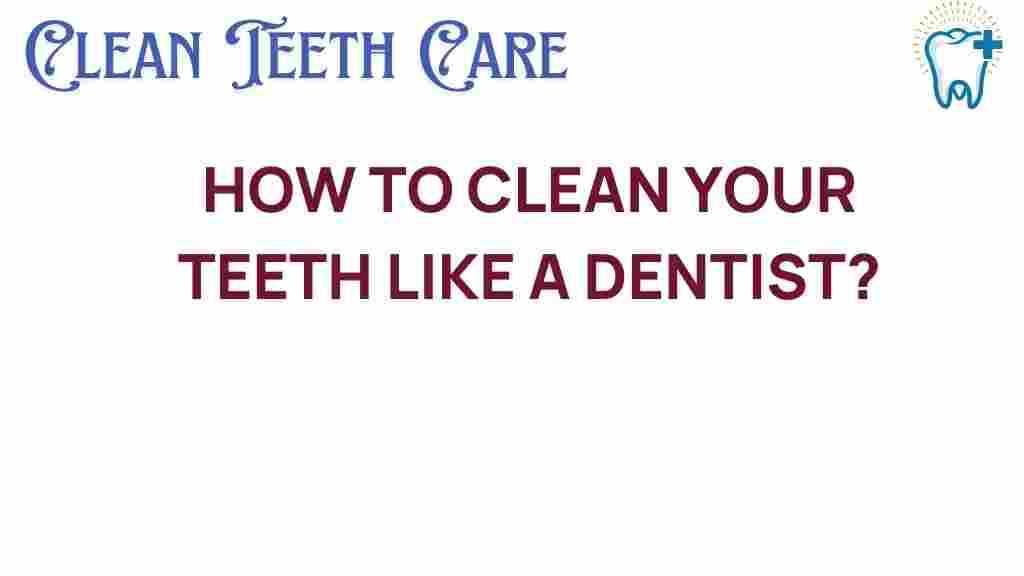Mastering Dental Hygiene: How to Clean Your Teeth Like a Dentist
Maintaining excellent dental hygiene is essential for achieving a healthy smile. Proper teeth cleaning not only helps to prevent cavities, gum disease, and bad breath but also contributes significantly to overall oral health. In this article, we will explore effective techniques for cleaning your teeth like a dentist, providing you with valuable dentist tips for optimal plaque removal, proper brushing techniques, and efficient flossing methods. You’ll also learn how to incorporate mouthwash into your routine for a complete dental care regimen.
The Importance of Dental Hygiene
Good dental hygiene is the foundation of a healthy mouth. Neglecting your oral care can lead to numerous problems, including:
- Cavities
- Gum disease
- Tooth loss
- Bad breath
- Increased risk of systemic diseases
By mastering the art of teeth cleaning, you can ensure that your mouth remains healthy and vibrant. Let’s delve into the step-by-step process of achieving professional-level dental hygiene at home.
Step-by-Step Process for Effective Teeth Cleaning
1. Gather Your Tools
Before you begin your dental hygiene routine, gather the following tools:
- Soft-bristled toothbrush
- Floss or interdental brushes
- Alcohol-free mouthwash
- Toothpaste with fluoride
- Timer or a smartphone app
2. Optimal Brushing Techniques
Brushing your teeth is crucial for effective plaque removal. Follow these brushing techniques to maximize your efforts:
- Angle Your Brush: Hold your toothbrush at a 45-degree angle to your gums. This position helps to clean the gum line effectively.
- Use Gentle Circular Motions: Instead of scrubbing back and forth, use gentle circular motions to remove plaque.
- Brush for Two Minutes: Use a timer to ensure you brush for a full two minutes, covering all areas of your mouth.
- Focus on All Surfaces: Brush the outer, inner, and chewing surfaces of each tooth. Don’t forget your tongue, as it can harbor bacteria.
For a more in-depth guide on brushing techniques, check out this [dental hygiene resource](#) that provides additional tips.
3. Flossing Like a Dentist
Flossing is an essential component of dental hygiene that many people overlook. Here’s how to floss effectively:
- Choose the Right Floss: Opt for waxed floss if you have tight contacts between teeth or unwaxed if you prefer a thinner option.
- Use About 18 Inches: Cut a piece of floss about 18 inches long. Wrap it around your middle fingers, leaving about two inches to work with.
- Guide the Floss: Gently slide the floss between your teeth. Curve it around the base of each tooth, making sure to go beneath the gum line.
- Use a Clean Section: As you move from tooth to tooth, unroll a fresh section of floss to avoid transferring plaque.
4. Rinse with Mouthwash
Using mouthwash is an excellent way to enhance your oral health. Consider these tips when choosing and using mouthwash:
- Select the Right Mouthwash: Look for an alcohol-free mouthwash that contains fluoride for added protection against cavities.
- Follow Instructions: Rinse for the recommended time, usually around 30 seconds to one minute, to ensure maximum efficacy.
- Use Mouthwash After Brushing and Flossing: This order allows you to remove any remaining debris before rinsing.
5. Establish a Routine
To achieve a healthy smile, consistency is key. Here’s how to establish a solid dental hygiene routine:
- Brush Twice Daily: Make sure to brush your teeth in the morning and before bed.
- Floss Once Daily: Choose a time that works for you, whether it’s in the morning or at night.
- Visit Your Dentist Regularly: Schedule dental check-ups every six months for professional cleaning and oral examination.
Troubleshooting Common Dental Hygiene Issues
Even with the best intentions, you may face challenges in maintaining your dental hygiene. Here are some common issues and solutions:
1. Sensitive Teeth
If you experience sensitivity while brushing or flossing, consider switching to a toothpaste designed for sensitive teeth. Additionally, be gentle with your brushing technique.
2. Bleeding Gums
Bleeding gums can indicate gum disease or improper brushing/flossing techniques. Ensure you are using the right techniques, and consult your dentist if the bleeding persists.
3. Bad Breath
Persistent bad breath may stem from inadequate cleaning or underlying dental issues. Ensure you brush your tongue and use mouthwash to combat bacteria. If the problem continues, see your dentist.
Conclusion
Mastering dental hygiene is vital for maintaining a healthy smile and preventing oral diseases. By following these expert dentist tips for teeth cleaning, including effective brushing techniques, proper flossing, and the use of mouthwash, you can achieve the level of care that promotes excellent oral health. Remember that consistency is crucial; establish a routine that includes regular dental visits for professional care. With dedication and the right approach, you can enjoy a life filled with confidence and a radiant smile.
For more information on maintaining oral health, visit this [external resource](#) that provides comprehensive dental care tips.
This article is in the category Hygiene and created by CleanTeethCare Team
